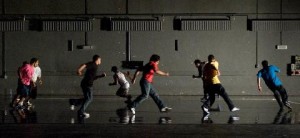Since they are not easy to print at the moment, we’ll fix this, I’m adding the introductory essays—THE DANCE, THE DATA, THE OBJECTS—to the blog. They are important ways in to understanding what we’re up to with the project. -Norah
The Dance
One Flat Thing, reproduced (OFTr) is an ensemble dance that examines and reconfigures classical choreographic principles of counterpoint. In OFTr counterpoint is defined as “a field of action in which the intermittent and irregular coincidence of attributes between organizational elements produces an ordered interplay” (Forsythe). Three structural systems interact to create the counterpoint of the dance: movement material, cueing, and alignments.
Movement Material
This contrapuntal dance is composed of fixed movement material with some instances of structured improvisation. While there is no set terminology, members of the company most often refer to the different segments of fixed movement as themes. The 25 main themes are repeated and recombined over the course of the dance in their full and partial forms. In addition to the themes and their interpretation, there is a set of improvisation tasks in OFTr that ask dancers to translate specific properties of other performers’ motions into their own. The dancers observe each other and make these translations in real time, producing different results in each performance of the work.
Cueing
The sequence of OFTr is organized by an elaborate cueing system that acts as an internal clock. Rather than following an external musical structure, the dancers collectively determine the flow of the dance as they give and receive cues (aural or visual signals that trigger events). With more than 200 cues in the dance, responsibility for cueing is distributed among all the dancers
Alignments
Essential to the counterpoint of the dance is a system of relationships that the company refers to as alignments. Alignments are short instances of synchronization between dancers in which their actions share some, but not necessarily all, attributes. Manifested as analogous shapes, related timings, or corresponding directional flows, alignments occur in every moment of the dance and are constantly shifting throughout the group. The term alignment emerges from the working practices of the Forsythe Company. Other words the company uses to describe this phenomenon include hook-ups, agreements, and isometries. Within the thousands of alignments in the choreography, approximately 200 can be understood as a subset called sync-ups. These are moments in the choreography when a dancer’s task is to briefly join with another individual or group.
—William Forsythe and Norah Zuniga Shaw, Columbus, Ohio, January 2009
Stats:
One Flat Thing, reproduced
Stage premiere: 2000, Bockenheimer Depot, Frankfurt, Germany
Choreography: William Forsythe
Music: Thom Willems
Source video: 2005, Bockenheimer Depot, Frankfurt, Germany (15 minutes 30 seconds)
Dancers (17): Yoko Ando, Cyril Baldy, Francesca Caroti, Dana Caspersen,
Amancio Gonzalez, Sang Jijia, David Kern, Marthe Krummenacher, Prue Lang,
Ioannis Mantafounis, Fabrice Mazliah, Roberta Mosca, Georg Reischl,
Jone San Martin, Christopher Roman, Elizabeth Waterhouse, Ander Zabala
(c) 2009 Synchronous Objects




Recent Comments